Ozan Alp Topal
Green One-Bit Quantized Precoding in Cell-Free Massive MIMO
Jul 30, 2025Abstract:Cell-free massive MIMO (multiple-input multiple-output) is expected to be one of the key technologies in sixth-generation (6G) and beyond wireless communications, offering enhanced spectral efficiency for cell-edge user equipments by employing joint transmission and reception with a large number of antennas distributed throughout the region. However, high-resolution RF chains associated with these antennas significantly increase power consumption. To address this issue, the use of low-resolution analog-to-digital and digital-to-analog converters (ADCs/DACs) has emerged as a promising approach to balance power efficiency and performance in massive MIMO networks. In this work, we propose a novel quantized precoding algorithm tailored for cell-free massive MIMO systems, where the proposed method dynamically deactivates unnecessary antennas based on the structure of each symbol vector, thereby enhancing energy efficiency. Simulation results demonstrate that our algorithm outperforms existing methods such as squared-infinity norm Douglas-Rachford splitting (SQUID) and regularized zero forcing (RZF), achieving superior performance while effectively reducing power consumption.
Fair and Energy-Efficient Activation Control Mechanisms for Repeater-Assisted Massive MIMO
Apr 04, 2025Abstract:Massive multiple-input multiple-output (mMIMO) has been the core of 5G due to its ability to improve spectral efficiency and spatial multiplexing significantly; however, cell-edge users still experience performance degradation due to inter-cell interference and uneven signal distribution. While cell-free mMIMO (cfmMIMO) addresses this issue by providing uniform coverage through distributed antennas, it requires significantly more deployment cost due to the fronthaul and tight synchronization requirements. Alternatively, repeater-assisted massive MIMO (RA-MIMO) has recently been proposed to extend the coverage of cellular mMIMO by densely deploying low-cost single-antenna repeaters capable of amplifying and forwarding signals. In this work, we investigate amplification control for the repeaters for two different goals: (i) providing a fair performance among users, and (ii) reducing the extra energy consumption by the deployed repeaters. We propose a max-min amplification control algorithm using the convex-concave procedure for fairness and a joint sleep mode and amplification control algorithm for energy efficiency, comparing long- and short-term strategies. Numerical results show that RA-MIMO, with maximum amplification, improves signal-to-interference-plus-noise ratio (SINR) by over 20 dB compared to mMIMO and performs within 1 dB of cfmMIMO when deploying the same number of repeaters as access points in cfmMIMO. Additionally, our majority-rule-based long-term sleep mechanism reduces repeater power consumption by 70% while maintaining less than 1% spectral efficiency outage.
UAV-Based Cell-Free Massive MIMO: Joint Placement and Power Optimization under Fronthaul Capacity Limitations
Feb 07, 2025
Abstract:We consider a cell-free massive multiple-input multiple-output (mMIMO) network, where unmanned aerial vehicles (UAVs) equipped with multiple antennas serve as distributed UAV-access points (UAV-APs). These UAV-APs provide seamless coverage by jointly serving user equipments (UEs) with out predefined cell boundaries. However, high-capacity wireless networks face significant challenges due to fronthaul limitations in UAV-assisted architectures. This letter proposes a novel UAV-based cell-free mMIMO framework that leverages distributed UAV-APs to serve UEs while addressing the capacity constraints of wireless fronthaul links. We evaluate functional split Options 7.2 and 8 for the fronthaul links, aiming to maximize the minimum signal-to-interference-plus-noise ratio (SINR) among the UEs and minimize the power consumption by optimizing the transmit powers of UAV-APs and selectively activating them. Our analysis compares sub-6 GHz and millimeter wave (mmWave) bands for the fronthaul, showing that mmWave achieves superior SINR with lower power consumption, particularly under Option 8. Additionally, we determine the minimum fronthaul bandwidth required to activate a single UAV-AP under different split options.
Detecting Unauthorized Drones with Cell-Free Integrated Sensing and Communication
Jan 25, 2025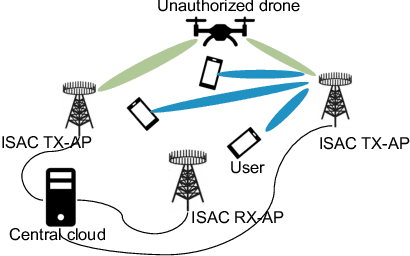
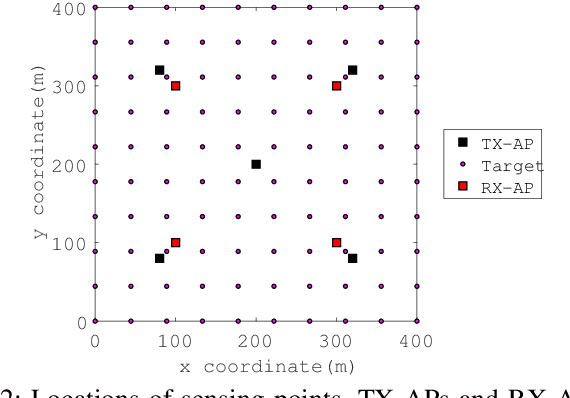

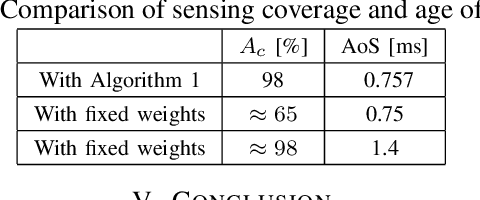
Abstract:Integrated sensing and communication (ISAC) boosts network efficiency by using existing resources for diverse sensing applications. In this work, we propose a cell-free massive MIMO (multiple-input multiple-output)-ISAC framework to detect unauthorized drones while simultaneously ensuring communication requirements. We develop a detector to identify passive aerial targets by analyzing signals from distributed access points (APs). In addition to the precision of the sensing, timeliness of the sensing information is also crucial due to the risk of drones leaving the area before the sensing procedure is finished. We introduce the age of sensing (AoS) and sensing coverage as our sensing performance metrics and propose a joint sensing blocklength and power optimization algorithm to minimize AoS and maximize sensing coverage while meeting communication requirements. Moreover, we propose an adaptive weight selection algorithm based on concave-convex procedure to balance the inherent trade-off between AoS and sensing coverage. Our numerical results show that increasing the communication requirements would significantly reduce both the sensing coverage and the timeliness of the sensing. Furthermore, the proposed adaptive weight selection algorithm can provide high sensing coverage and reduce the AoS by 45% compared to the fixed weights, demonstrating efficient utilization of both power and sensing blocklength.
Communicate or Sense? AP Mode Selection in mmWave Cell-Free Massive MIMO-ISAC
Dec 03, 2024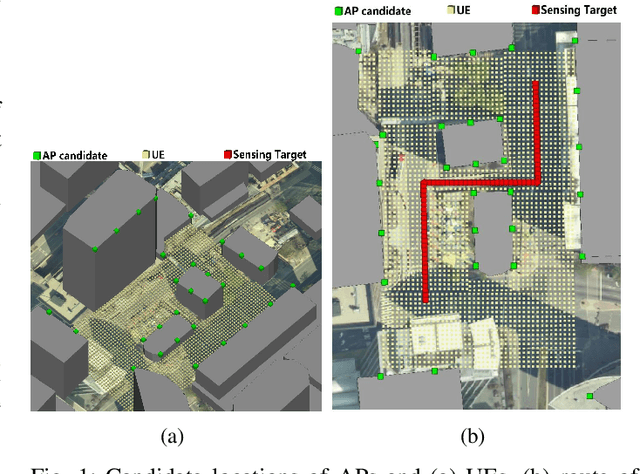
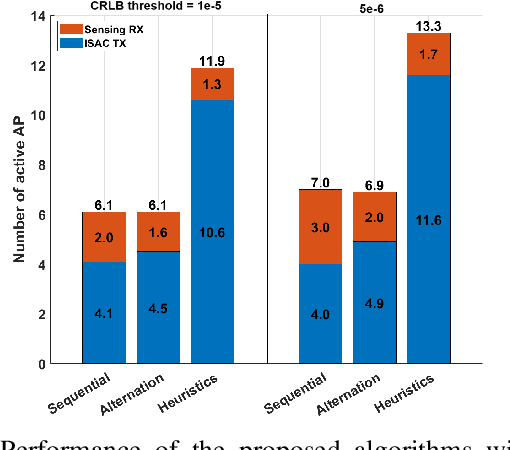

Abstract:Integrated sensing and communication (ISAC) is a promising technology for future mobile networks, enabling sensing applications to be performed by existing communication networks, consequently improving the system efficiency. Millimeter wave (mmWave) signals provide high sensing resolution and high data rate but suffer from sensitivity to blockage. Cell-free massive multiple-input multiple-output (MIMO), with a large number of distributed access points (APs), can overcome this challenge by providing macro diversity against changing blockages and can save energy consumption by deactivating unfavorable APs. Thus, in this work, we propose a joint dynamic AP mode selection and power allocation scheme for mmWave cell-free massive MIMO-ISAC, where APs are assigned either as ISAC transmitters, sensing receivers, or shut down. Due to the large size of the original problem, we propose three different sub-optimal algorithms that minimize the number of active APs while guaranteeing the sensing and communication constraints. Numerical results demonstrate that assigning ISAC transmitters only satisfying communication constraints, followed up by sensing receiver assignment only for sensing constraint achieves the best performance-complexity balance.
Energy-Efficient Cell-Free Massive MIMO with Wireless Fronthaul
Dec 03, 2024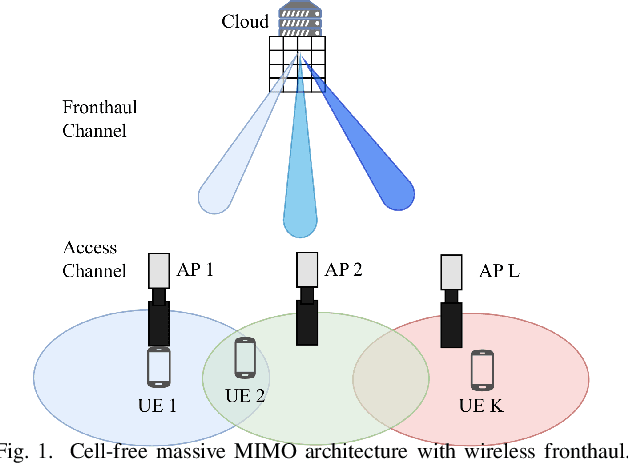
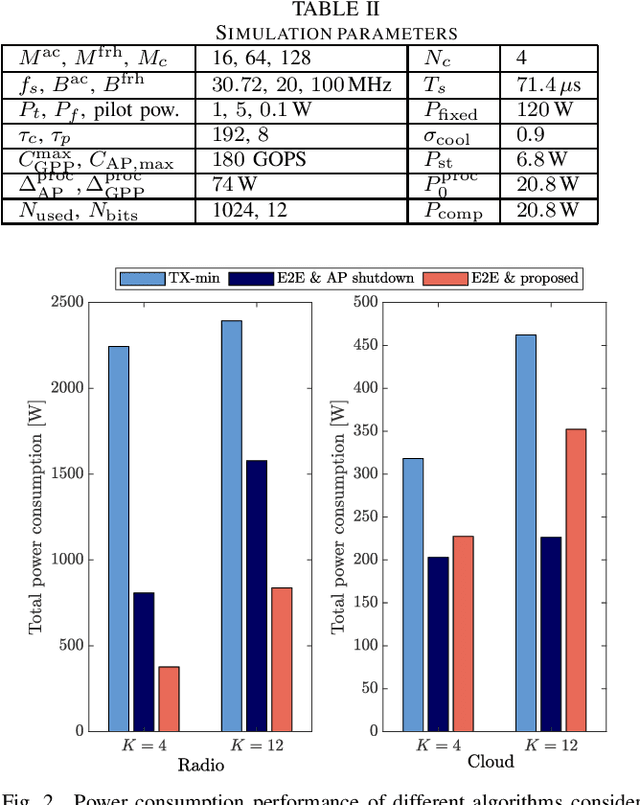
Abstract:Cell-free massive MIMO improves the fairness among the user equipments (UEs) in the network by distributing many cooperating access points (APs) around the region while connecting them to a centralized cloud-computing unit that coordinates joint transmission/reception. However, the fiber cable deployment for the fronthaul transport network and activating all available antennas at each AP lead to increased deployment cost and power consumption for fronthaul signaling and processing. To overcome these challenges, in this work, we consider wireless fronthaul connections and propose a joint antenna activation and power allocation algorithm to minimize the end-to-end (from radio to cloud) power while satisfying the quality-of-service requirements of the UEs under wireless fronthaul capacity limitations. The results demonstrate that the proposed methodology of deactivating antennas at each AP reduces the power consumption by 50% and 84% compared to the benchmarks based on shutting down APs and minimizing only the transmit power, respectively.
Multi-Target Integrated Sensing and Communications in Massive MIMO Systems
Oct 29, 2024Abstract:Integrated sensing and communications (ISAC) allows networks to perform sensing alongside data transmission. While most ISAC studies focus on single-target, multi-user scenarios, multi-target sensing is scarcely researched. This letter examines the monostatic sensing performance of a multi-target massive MIMO system, aiming to minimize the sum of Cram\'er-Rao lower bounds (CRLBs) for target direction-of-arrival estimates while meeting user equipment (UE) rate requirements. We propose several precoding schemes, comparing sensing performance and complexity, and find that sensing-focused precoding with power allocation for communication achieves near-optimal performance with 20 times less complexity than joint precoding. Additionally, time-sharing between communication and sensing outperforms simple time division, highlighting the benefits of resource-sharing for ISAC.
Self-Sustainable Metasurface-Assisted mmWave Indoor Communication System
Jul 22, 2024Abstract:In the design of a metasurface-assisted system for indoor environments, it is essential to take into account not only the performance gains and coverage extension provided by the metasurface but also the operating costs brought by its reconfigurability, such as powering and cabling. These costs can present challenges, particularly in indoor dense spaces (IDSs). A self-sustainable metasurface (SSM), which retains reconfigurability unlike a static metasurface (SMS), achieves a lower operating cost than a reconfigurable intelligent surface (RIS) by being self-sustainable through power harvesting. In this paper, in order to find a better trade-off between metasurface gain, coverage, and operating cost, the design and performance of an SSM-assisted indoor mmWave communication system are investigated. We first simplify the design of the SSM-assisted system by considering the use of SSMs in a preset-based manner and the formation of coverage groups by associating SSMs with the closest user equipments (UEs). We propose a two-stage iterative algorithm to maximize the minimum data rate in the system by jointly deciding the association between the UEs and the SSMs, the phase-shifts of the SSMs, and allocating time resources for each UE. The non-convexities that exist in the proposed optimization problem are tackled using the feasible point pursuit successive convex approximation method and the concave-convex procedure. To understand the best scenario for using SSM, the resulting performance is compared with that achieved with RIS and SMS. Our numerical results indicate that SSMs are best utilized in a small environment where self-sustainability is easier to achieve when the budget for operating costs is tight.
Mixed Static and Reconfigurable Metasurface Deployment in Indoor Dense Spaces: How Much Reconfigurability is Needed?
Feb 01, 2024



Abstract:In this paper, we investigate how metasurfaces can be deployed to deliver high data rates in a millimeter-wave (mmWave) indoor dense space with many blocking objects. These surfaces can either be static metasurfaces (SMSs) that reflect with fixed phase-shifts or reconfigurable intelligent surfaces (RISs) that can reconfigure their phase-shifts to the currently served user. The latter comes with an increased power, cabling, and signaling cost. To see how reconfigurability affects the network performance, we propose an iterative algorithm based on the feasible point pursuit successive convex approximation method. We jointly optimize the types and phase-shifts of the surfaces and the time portion allocated to each user equipment to maximize the minimum data rate achieved by the network. Our numerical results demonstrate that the minimum data rate improves as more RISs are introduced but the gain diminishes after some point. Therefore, introducing more reconfigurability is not always necessary. Another result shows that to reach the same data rate achieved by using 22 SMSs, at least 18 RISs are needed. This suggests that when it is costly to deploy many RISs, as an inexpensive alternative solution, one can reach the same data rate just by densely deploying more SMSs.
mmWave Coverage Extension Using Reconfigurable Intelligent Surfaces in Indoor Dense Spaces
Feb 18, 2023



Abstract:In this work, we consider the deployment of reconfigurable intelligent surfaces (RISs) to extend the coverage of a millimeter-wave (mmWave) network in indoor dense spaces. We first integrate RIS into ray-tracing simulations to realistically capture the propagation characteristics, then formulate a non-convex optimization problem that minimizes the number of RISs under rate constraints. We propose a feasible point pursuit and successive convex approximation-based algorithm, which solves the problem by jointly selecting the RIS locations, optimizing the RIS phase-shifts, and allocating time resources to user equipments (UEs). The numerical results demonstrate substantial coverage extension by using at least four RISs, and a data rate of 130 Mbit/s is guaranteed for UEs in the considered area of an airplane cabin.
 Add to Chrome
Add to Chrome Add to Firefox
Add to Firefox Add to Edge
Add to Edge